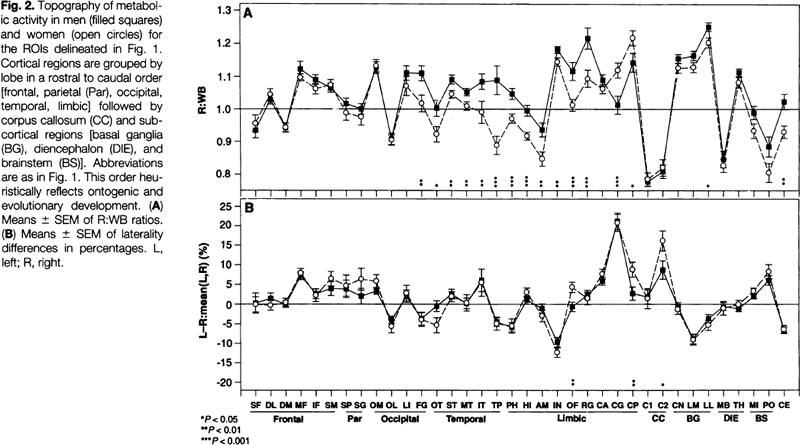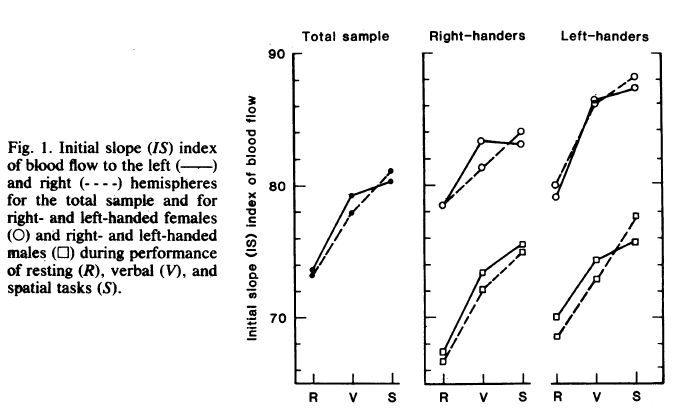September 06, 2006
The vast arctic tundra of the male brain
Jessica Richard sent in another sighting of the sex-linked word-budget meme. Kim Underwood, writing in the Winston-Salem Journal, quoted it in describing a recent talk by Michael Gurian, who was speaking to "parents, teachers and others" in a North Carolina school auditorium ("HARD-WIRED: Many learning differences between boys and girls are innate, expert says", August 27, 2006):
Words come more readily to girls. Even as adults, men use fewer words than women. Studies have shown that, on average, women speak about 20,000 words in a day. Depending on the study, men use 7,000 to 10,000.
"That is a big difference," Gurian said. "Most guys all the way through life are going to use less words."
Boy, I wish that I could find even one of those studies! As I wrote in my earlier posts on the subject, lots of writers and speakers throw such numbers around, but none of them ever actually cite a reputable scientific study -- or even a disreputable one. ("Sex-linked lexical budgets", 8/6/2006, and "The laconic rapist in the womb", 9/4/2006.) If you can point me to a study that supports such numbers, please write.
Gurian frames his picture of innate sex differences in roughly the same terms as other authors such as Leonard Sax and Louann Brizendine:
We need to understand that many of the differences between boys and girls are hard-wired, he said. (In an interview before his talk, he said that you could say it's because God made us that way or because men developed as hunters through time. Either way, it is the way it is.)
Boys' brains are designed to focus on - among other things - the ways that objects move through space. Girls' brains are designed to focus on - among other things - language and establishing and maintaining connections.
This perspective is neither unique to scientists nor especially new, though it's recently been given new life by being linked with new research in neuroscience. Gurian has been doing business at this stand for while -- his popular books on the subject include:
Michael Gurian and Kathy Stevens, The minds of boys: saving our sons from falling behind in school and life, 2005
Michael Gurian, Boys and Girls Learn Differently!: A Guide for Teachers and Parents, 2002
Michael Gurian, The wonder of boys, 1997
All of these authors present their ideas as good for both boys and girls -- if we recognize the innate differences between the sexes, and treat them in appropriately different ways in school, at home and in the workplace, both sexes will benefit. That's the theory, and it might well be true.
But there are two things about this that I find disturbing.
In the first place, the ideas about what men and women are like haven't really changed much from the days when such theories were used to argue against women's suffrage or careers for women outside the home. The stories are now usually framed so as to make fun of males and praise women, but that's just a matter of how the advertising copy is written. These authors generally present a rather unpleasant picture of what boys and men are like: uncommunicative, out of touch with their emotions, distractable, obsessed with sex, aggressive and competitive. The idea seems to be that this is OK as retribution for all the years of negative stereotypes of girls and women -- and after all, similar ideas have been endorsed by many feminist writers. But the inverse picture of girls and women, though now framed in positively-evaluated terms, is pretty much the same the old negative stereotype of women as over-sensitive, over-emotional, manipulative gossips, who need to be protected from the rough-and-tumble world of men.
Maybe these ideas recur so consistently because they're true. But the second thing that bothers me about the stuff I've seen recently is that the "scientific" evidence presented for these allegedly innate cognitive differences is incredibly shoddy. It's full of selective viewing, over-interpretation, mis-interpretation and good old-fashioned invention.
You can see some of this in Underwood's article about Gurian's talk in that high school auditorium in North Carolina:
... listening to Gurian - who spoke to teachers, parents and others on Monday in the auditorium at Summit School - was like listening to a stand-up comic present a scientific paper.
Gurian elicited one of the bigger laughs when he projected images of brain scans on a screen. One showed a male brain at rest. The other showed a female brain at rest. As he described what the different colors meant, it became clear that even at rest, a female brain is still pretty active.
The male brain, on the other hand, brought to mind the vast, treeless plains of the arctic tundra. Pointing to one of only a couple of spots of modest activity, Gurian said, "The guy has got to breathe."
This is clever, I think, because it validates the idea of innate sex differences by making fun of men's calm rationality empty-headed cluelessness compared to the frantic scheming active mental life of women. The trouble is, any way you spin it, the "neuroscience" presented here appears to be a total fraud.
Gurian makes what seems to be the same point about resting brains on p. 51 of his 2005 book with Kathy Stevens, The minds of boys: saving our sons from falling behind in school and life:
As Ruben Gur has observed, "In the resting female brain, we find just as much neural activity as in the male brain that is solving problems." The female brain, in other words, doesn't really go to a rest state in the way the male does. Female blood flow even during brain rest is very active. Male blood flow during a rest state is not.
The book then shows two pretty random-looking brain scan pictures as illustrations (I presume that Gurian's road show shows such pictures in more impressive color versions):

I couldn't find any reference for the quote from Ruben Gur, who's on the faculty here at Penn. I'll ask him if he ever said this or something like it; but until I hear from him, we can rely on what he wrote in (what I think is) the only scientific paper that he's published on this particular subject: RC Gur et al., "Sex differences in regional cerebral glucose metabolism during a resting state", Science 267(5197) 528-531 (1995) . The abstract:
Positron emission tomography was used to evaluate the regional distribution of cerebral glucose metabolism in 61 healthy adults at rest. Although the profile of metabolic activity was similar for men and women, some sex differences and hemispheric asymmetries were detectable. Men had relatively higher metabolism than women in temporal-limbic regions and cerebellum and relatively lower metabolism in cingulate regions. In both sexes, metabolism was relatively higher in left association cortices and the cingulate region and in right ventro-temporal limbic regions and their projections. These results are consistent with the hypothesis that differences in cognitive and emotional processing have biological substrates.
(Note that glucose metabolism in the brain is a good proxy for neural activity, and is the basis for the hemodynamic reactions that are the basis of fMRI imaging.) In the body of the paper, we learn that
Average metabolism calculated from WB [whole brain] counts did not differ between men (mean ± SD, 4.66 ± 0.97 ml per 100 g of tissue mass per minute) and women (4.62 ± 1.09).
There were some local differences, some favoring men and some favoring women, as shown in the following figure:

In contrast, Michael Gurian's story, as filtered through the perceptions of the reporter who heard his talk:
...even at rest, a female brain is still pretty active. The male brain, on the other hand, brought to mind the vast, treeless plains of the arctic tundra.
In Gurian's own published words:
The female brain, in other words, doesn't really go to a rest state in the way the male does. Female blood flow even during brain rest is very active. Male blood flow during a rest state is not.
If there's some other research out there that supports Gurian's claim, I'll apologize to him. But on the basis of what I can see so far, it looks like he's presenting a fable entirely lacking in scientific foundation, and using some irrelevant brain-scan pictures to try to snow people into believing that it's neurological gospel. If so, this is a great example of the effect that Deena Skolnick recently demonstrated, in which completely irrelevant bits of inserted neuroscience cause readers -- even sophisticated ones -- to see bad arguments as satisfactory ones.
[Update 9/6/2006 -- Ruben Gur responded:
I'm not entirely sure where Gurian got that quote, it doesn't sound like something I wrote although I could have said something like it in a talk. It would be in reference to one of first findings on sex differences, even before the age of PET. We used the 133-xenon clearance method for measuring cerebral blood flow (CBF) and found that women had higher rates of CBF. At the time I was confronted repeatedly with the question: "well, perhaps women just have to think harder, put more efforts into thinking". My stock answer was similar to Gurian's quote, as I would point out that we measured CBF at rest and during problem solving, and womens' resting values were already higher than that for men. Indeed, they were at about the range we found in men when they were solving problems. [Gur RC, Gur RE, Obrist WD, Hungerbuhler JP, Younkin D, Rosen AD, Skolnick BE., Reivich M. "Sex and handedness differences in cerebral blood flow during rest and cognitive activity". Science, 1982, 217, 659-661.] The rest of the quote from Gurian is his own take, which I'm not sure about. I actually think the story is a bit more complicated, and interesting, but I doubt that it means that women "think harder" when they rest .
The higher CBF in women was since replicated in many studies with PET and more recently with perfusion MR. This is noteworthy especially given that the cerebral metabolic rates for glucose (CMRgl) are identical in men and women (as shown in the paper you quoted). It suggests that women have "luxury perfusion", i.e. more CBF than is needed for CMRgl. This could possibly explain why they have more robust brains (at least ones that survive a decade longer). But this is a paper i'm still working on "as we speak".
Here's the relevant figure from Gur et al. 1982:

The paper states that overall, the size of the CBF difference between females and males was about 15% (at least as measured by the initial slope of 133Xe clearance in the particular regions of brain seen by their detectors). And the figure certainly does show higher CBF rates for females in the resting condition than for males in the two problem-solving conditions. So I guess I owe Gurian an apology. He didn't just make this stuff up, he got it from Ruben Gur, perhaps with a bit of embroidery.
However, the apology is a qualified one, for several reasons.
First, as I understand the situation, rate of glucose metabolism is a better proxy for "neural activity" (say in terms of rate of neuron firing) than cerebral blood flow is -- see Wikipedia's summary of the relationship among neural signals, CBF and fMRI BOLD measurements. As Gur et al. said about the sex difference in CBF in the 1982 paper:
"...its explanation is unclear. An interpretation of the functional significance of this difference would depend on whether it is accompanied by sex differences in neuronal activity and cerebral metabolism, which are highly coupled in the normal brain. Sex differences in metabolism could be directly tested in humans by use of positron emission tomography."
That PET testing is what Gur et al. 1995 did, 13 years later. They found no sex difference in CMRgl. Thus the measured sex difference in CBF does not seem consistent with a sex difference in "neural activity".
Second, some of the measurements we're talking about are expressed per unit volume, or calculated in a way that compares comparable volumes, while others are calculated for the whole brain, or with other, more complex, geometric properties. Gur's CBF measurements rely on detectors that "measure flow in a cylinder of tissue that includes primarily cortex and underlying white matter, and to a diminished extent deeper structures". Keep in mind that cerebral volume is about 10% greater on average in males than in females, from childhood onwards (e.g. Reiss et al., "Brain development, gender and IQ in children: A volumetric imaging study", Brain, 119(5) 1763-1774, 1996). There are also sex differences in relative volumes of gray matter and white matter -- and different differences in relative thicknesses of gray matter as seen from a given point on the cortical surface -- and "gray matter ... has a perfusion rate approximately four times and a clearance rate approximately seven times that of white matter", according to Gur et al. 1982.
I'd like to see a careful analysis of the effects of these anatomical differences, which are by far the best-established sex differences in brain parameters, on the issues under discussion here. Which differences in measured functional parameters are functionally meaningful, and which are just a function of geometric scaling interacting with the known anatomical differences and the techniques or scales of functional measurement?
This question of sex differences in brain function has serious implications for public policy. As I've explained in other other posts on this topic, some of the compelling pop-neuroscience stories in the news these days are based on misquoted or simply invented numbers. But even when the numbers are real, let's not jump to conclusions about their meaning -- whether those numbers seem to show an advantage for women, as the current fashion dictates, or seem to "explain" the dominance of men in certain areas of human activity. You might enjoy the idea that female brains are warm, busy, colorful places, while male brains are "like the vast, treeless plains of the arctic tundra". But it doesn't matter who you're rooting for in this "neuroscience world cup" that compares sexes, races, national groups, professions and personality types on a host of anatomical and functional dimensions. Once you start accepting simplistic over-interpretations of such results in connection with your favorite group stereotypes, pretty soon you'll find yourself confronted with some similarly evocative results that you don't like at all.
And that's not just because there are facts of group differences that "are what they are", as Gurian and others like to tell us. It's also because some people will use isolated, misinterpreted or even invented bits of "science" for reasons of political calculation or personal ambition, and some groups will latch onto any neuropolitical memes that suit their interests or their prejudices. So let's be careful out there. ]
Posted by Mark Liberman at September 6, 2006 05:02 AM